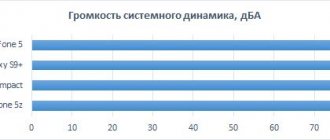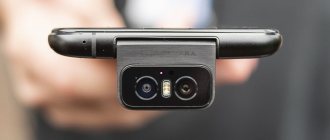- Equipment
- Design
- Screen
- Performance
- Camera
- Autonomy
- Characteristics
- Conclusion
The Xiaomi company continues to expand the model range of its flagship smartphone Xiaomi Mi 8, presented at the beginning of the summer of this year.
A logical development of the model is the new Xiaomi Mi 8 Pro phone, which contains a number of changes that improve the performance of the product. In our review of Xiaomi Mi 8 Pro, we will tell you what the manufacturer has changed in the device and what advantages it has.
Kit contents
The device is packaged in a stylish black box, which only contains the model name. Inside, the user, in addition to the smartphone itself, will find a brief instruction manual in Chinese, a charger, and a warranty card.
As a nice bonus, the kit includes an adapter from a Type-C connector to a 3.5 mm audio output, so users can easily use headsets with different connectors.
What has changed in design
Externally, the Mi8 Pro almost completely repeats the design of its predecessor, but the key feature is that the new modification is equipped with a fingerprint sensor built into the screen. For this reason, on the back side there is only a photo module protruding slightly beyond the body.
The peculiarity of the new fingerprint sensor is that it recognizes the pressure applied, so the level of protection for the gadget has increased slightly. To prevent unauthorized access to user data, Face ID technology is also implemented.
The manufacturer also offered new color options for the Xiaomi Mi 8 Pro. Users can choose between a gradient rose gold, translucent back cover, and classic black.
Small changes also affected the dimensions of the product, which slightly added weight (177 versus 164 grams for the classic eight). Accordingly, the dimensions have grown a little, which now amount to 154.9x74.8x7.6 mm.
The smartphone itself has practically no frames, and at the top of the screen there is already a familiar “unibrow”.
Face unlock and in-screen scanner
According to the company's management, Xiaomi Mi 8 Pro comes with the fastest facial recognition technology. There is also every reason to believe that the device has the fastest fingerprint scanner built right into the screen. Now the market is dominated by mobile gadgets with “ill-fated” bangs, but users are still indignant at this decision. To satisfy their customers, several manufacturers have taken a slightly different path, implementing the most interesting ideas, such as the pop-up front camera in VIVO NEX, the slider mechanism in OPPO Find X and the upcoming Xiaomi Mi MIX 3.
However, the notch screen is the most popular solution for flagships, and it is probably the most reliable solution. Of course, many can easily blame Xiaomi for not using the so-called waterdrop notch, as on VIVO X23. But there is a logical answer: Xiaomi Mi 8 Pro can recognize faces in the dark. The infrared module simply could not fit into the small cutout.
See also: Google Pixel 4 teaser: multi-module camera included
Xiaomi Mi 8 Pro uses the same face unlock technology that is present in the standard version of Mi 8. Compared to the usual RGB camera on other mobile gadgets, the Mi 8 Pro module emits infrared light invisible to the human eye with a wavelength of about 940 nm. The infrared illuminator easily illuminates the user's face, and the infrared camera captures the image. Then it is analyzed and the smartphone is quietly unlocked. The advantage of this method is the ability to work with the phone at night.
Although the 3D facial scanning method is indeed considered more secure than the standard one, the current version of MIUI does not support facial scanning as a method for confirming payments. Perhaps this function will appear a little later.
Hardware: improvements are noticeable
In terms of internal content, Xiaomi Mi 8 Pro is slightly superior to the basic version, since the simplest modification is offered with 6 GB of RAM and 128 GB of internal memory (remember that Xiaomi Mi 8 can be purchased in a 6+64 GB configuration). A more powerful version is offered with 8 gigabytes of RAM and 128 GB of internal storage.
The processor chosen is Snapdragon 845, which has eight cores, four of which have a frequency of 1.8 GHz, and the rest - 2.8 GHz.
Management is organized under Android 8.1 Oreo OS; by default, the new proprietary MIUI 10 shell is already used.
Camera Features
If you compare the photo modules of Xiaomi Mi 8 Pro with the original G8, then users will not find any difference. Both devices use a Sony IMX363 wide-angle matrix with an f/1.8 aperture and a resolution of 12 megapixels as the main module. The secondary sensor S5K3M3 also has 12 megapixels, but the aperture is already f/2.4.
The camera has a 2x optical zoom, four-axis video stabilization technology and a Dual Pixel AF image focusing system.
The front camera, which is equipped with a 20-megapixel sensor with f/2.0 aperture, is not far behind in its parameters. But the “lighter” version of Xiaomi Mi 8 Lite, despite its lower cost, has a front camera with a resolution of 24 megapixels.
Appearance
The first thing that immediately catches your eye when you look at the Xiaomi Mi 8 Pro is the absence of a fingerprint scanner on the back cover. This not only greatly affects the overall appearance, but also gives the device a certain solidity.
With the launch of Xiaomi Mi 8 Pro and Xiaomi Mi 8 Lite, the company was able to join many other manufacturers who use the reverse gradient effect as color solutions. This trend began with the release of Huawei P20 Pro, but now a large number of manufacturers (mostly Chinese) have gadgets of similar colors.
See also: Xiaomi Redmi K30 screen will be able to operate at a refresh rate of up to 120 Hz
The company offers 3 color options for the gadget. One of them is the translucent version that is already familiar to us. The second option is mirror glass in twilight gold color. And the third is a black meteorite. The most attractive version is Twilight Gold. Compared to the 4 colors available for the regular Xiaomi Mi 8 variant, this radically new variant will definitely appeal to the female half. The color of the back glass cover will shimmer from top red to bottom gold.
The transparent version of Xiaomi Mi 8 Pro is familiar to everyone; it follows the Explorer Edition design. It was the first mobile gadget in the world to use a pressure-sensitive in-display fingerprint sensor and Android's first 3D facial scanning technology. Thanks to such advanced technologies and the complexity of producing gadgets with a transparent back cover, the Mi 8 Explorer Edition is still in short supply. So the company decided to develop another mobile gadget to bring in-display fingerprint scanner technology to the masses, and it turned out to be the Xiaomi Mi 8 Pro.
The front part of the body is the same as in the regular version of Xiaomi Mi 8. The 6.21-inch AMOLED matrix made by Samsung is still used. The screen aspect ratio is 18.7:9. There is a notch in the screen, inside of which a large number of sensors are hidden, including the front camera and the infrared module. Xiaomi Mi 8 Pro supports the same face unlock technology as the Explorer Edition.
On the back of the Xiaomi Mi 8 Pro there is a dual camera identical to the standard version of the Mi 8. The main 12-megapixel sensor is Sony IMX363 with a pixel size of 1.4 microns, which supports dual autofocus and four-axis optical image stabilization.
Main characteristics of Xiaomi Mi 8 Pro
| Chipset | Snapdragon 845 |
| OS, shell | Android 8.1 Oreo, MIUI 10 |
| Screen | 6.21″, 2248x1080 pixels |
| Memory | 6+128 GB, 8+128 GB |
| Photomodule | 12+12 MP, front – 20 MP |
| Sensors | In-screen fingerprint scanner, electronic compass, accelerometer, barometer, Hall sensor, proximity and lighting sensor, gyroscope |
| Dimensions | 154.9x74.8x7.6 mm |
| Weight | 177 grams |
| Price | From 35,000 rubles |
Mi 8 EE - Xiaomi flagship at maximum speed
In addition to the main flagship Mi 8, the company today presented a special version, which is labeled Explorer Edition and, in fact, is an extended version of Mi 8. At the presentation it was said that the smartphone has a number of innovative technologies used for the first time in mobile gadgets.
Well, let's take a look at this beauty one by one and try to understand how cool and cool this smartphone is compared to its competitors.
Design and display
Xiaomi Mi 8 Explorer Edition received a 2.5D glass transparent back panel curved towards the edges of the device. This panel gives a complete picture of the insides of the smartphone: the motherboard, various cables, chipset, battery with Kevlar texture, and even the new design of the NFC module are visible. Mi 8 EE weighs 177 grams and has dimensions traditional for regular 5.2-inch smartphones - 154.9 x 74.8 x 7.6 mm.
The Super AMOLED display of the new product has a diagonal of 5.88 inches with an aspect ratio of 18.7:9 and a FullHD+ resolution of 2244 × 1080 pixels. The front panel coverage area is 86.12%. Like the original Mi 8, the display of the extended version supports DCI-P3 color gamut, has a contrast ratio of 60000:1 and a brightness of up to 600 nits, supports HDR mode, eye protection mode and the “Always-on-Display” function, when the display constantly displays Brief summary: time, notifications, weather with minimal battery consumption.
Under-display fingerprint scanner and 3D facial recognition
Mi 8 EE has an in-display fingerprint scanner that allows users to unlock their smartphone simply by touching it with their finger. Xiaomi claims that the display is equipped with a sensitive pressure sensor, so the user does not have to press hard on the screen: a light touch is enough. This is the first smartphone in the world with touch fingerprint recognition technology.
Like the iPhone X with the Face ID function, the Mi 8 EE has its own 3D scanning module, which allows it to project infrared light onto the user’s face, which is read by an infrared camera and unlocks the smartphone. In addition to the IR projector and IR camera, the cutout above the display contains a speaker, a proximity sensor, a light sensor and an earpiece.
The selfie camera records the data of every person who tries to unlock a smartphone, analyzing more than 33,000 points invisible to the human eye. By processing this data and data coming from the IR camera, the AI coprocessor, using complex mathematical algorithms, decides to grant permission to unlock the device. Xiaomi claims that the probability of error is 1 in 1,000,000. The figure is comparable to what Apple said at the presentation of the iPhone X and Face ID.
“Mi Meng” is the name of the analogue of Animoji in Chinese. Using AI algorithms, the selfie camera can capture the movements of 52 facial muscles, which are transmitted in real time to the avatar selected by the user. This avatar can imitate the movements and voice of the person who is currently looking at the camera.
Performance
Like Mi 8, Mi 8 EE is powered by Snapdragon 845, with 8 GB of RAM and 128 GB of ROM. The battery has a capacity of 3000 mAh, which supports the latest fast charging standard Quick Charge 4.0+. Out of the box, the smartphone comes pre-installed with Android 8.1 Oreo with the new proprietary MIUI 10 shell.
Camera and other features
Mi 8 EE is equipped with a dual camera: a main 12 MP Sony IMX363 f/1.8 module with a pixel size of 1.4 microns, and a secondary module, also 12 MP, S5K3M3 with an aperture of f/2.4 and a pixel size of 1 micron. Optical image stabilization, optical zoom and phase detection autofocus have not gone away. The camera can shoot 4K Ultra HD and FullHD video with a frame rate of 240 fps. After thorough testing, the camera received a high 105 points from the DxOMark agency.
The smartphone's selfie camera has a resolution of 20 megapixels, an f/2.0 aperture and a large pixel size of 1.8 microns. It also supports AI technologies by applying the effects of proprietary AI Portraits and AI Beauty functions to photos; recognizes more than 10 scenes, selecting optimal settings for each; can mirror the image and take HDR pictures.
Mi 8 EE supports dual SIM cards, 4G VoLTE, Bluetooth 5.0, USB Type-C and... A 3.5 mm audio jack is present in the smartphone too! Like the simple version of the flagship, the Explorer Edition is equipped with a dual-band GPS module for more accurate navigation in densely built environments.
Cost and Availability
The EE modification is available in only one configuration: 8/128 GB of RAM/ROM and costs 3,699 yuan ($577). Xiaomi has not yet said when the new product will go on sale.
You can also read about the original Mi 8 or the new fitness tracker Mi Band 3











